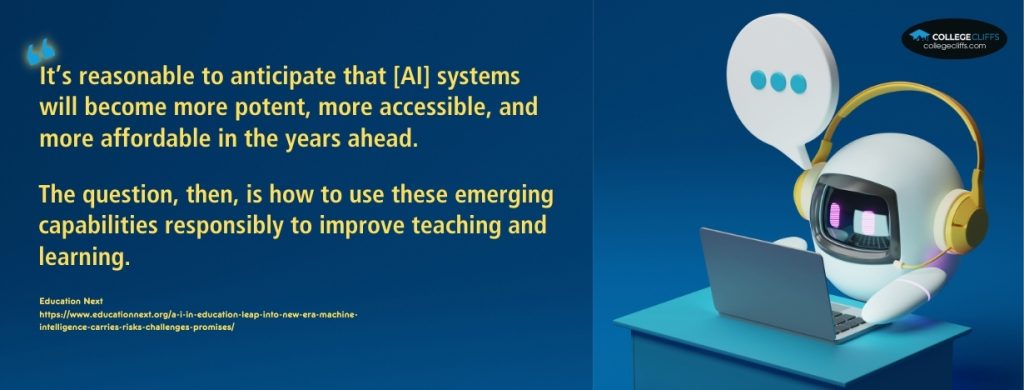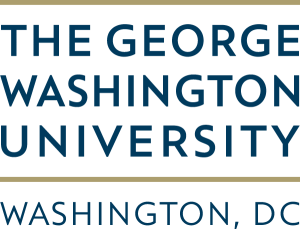Artificial Intelligence: The New College Rules That Have Come About
Find your perfect college degree
In this article, we will be covering...
Attending college is the first step toward realizing corporate aspirations. However, just as education needs have changed, so have the strategies students use to overcome obstacles.
In the era of artificial intelligence and fierce academic competition, more and more students find themselves using AI tools to finish their degrees.

First Off, What is AI?
Artificial intelligence, or AI, is the foundation for simulating human intelligence processes through the development and use of algorithms integrated into a dynamic computing environment. AI aims to mimic human thought and behavior in computers. It has three major components:
- Data and data management
- Computational systems
- Advanced AI algorithms (code)
More data and processing power are needed to achieve a more human-like result.
What Role Does AI Have in Higher Education?
Higher education is becoming increasingly competitive, forcing institutions to look for creative strategies to stay ahead of the competition. Artificial intelligence becomes a major actor in this changing environment by providing answers beyond conventional educational techniques.
AI is becoming increasingly integrated into college and university admissions procedures and individualized learning programs. The AI in Education market surpassed $4 billion in 2022 and is expected to grow by up to $30 million by 2032.
Pros of AI in Higher Education
In the enrollment process…
Artificial intelligence can significantly improve the enrollment process for new students. Modern IVR telephony systems offer self-service options related to admission, such as program requirements and application procedures.
Chatbots today engage prospective students in real-time conversation, guiding them through the application process and scheduling virtual campus tours.
Admissions officers can also set up AI-generated emails for auto-replies and reminders. This streamlines the enrollment process, freeing up time for more important topics, such as engaging with international students.
In the classroom…
Personalization is crucial in various sectors, including education. Educators struggle to understand each student’s needs and adapt teaching methods. AI and a modern data stack can help create personalized learning plans based on real-time assessments, tracking progress, and providing feedback.
AI also enables adaptive learning as it can continuously monitor progress and provide instant feedback to help students improve in any subject or area of interest.
Moreover, AI has revolutionized higher education by making learning more interactive and accessible. During the pandemic, institutions used teleconferencing tools to retain students’ interest and ensure equal access to education.
AI also enables accessibility for visually impaired students and those who don’t speak a language or are learning from different countries. Today, many institutions invest in VoIP, managing all communication from a single platform.
AI and human educators are working together more and more symbiotically. For example, intelligent tutoring and automated grading systems reduce administrative workloads for teachers so they can concentrate more on one-on-one instruction and mentorship.
This blend of technology and human touch produces a more enriching teaching environment.
Cons of AI in Higher Education
Despite the apparent benefits of AI in higher education, the rise of AI has seemed to cause alarm within the sector. This is especially true in the use of AI generative tools.
The main worry amongst institutions is that the implementation of AI will threaten important academic paradigms, such as those related to assessment, course design, activities, and more.
AI generates content that evades software that alerts instructors when students plagiarize. At the same time, it worries faculty members that students can use technology to shorten essays, other writing tasks, and exams.
Extreme dependence on AI
Over-reliance on AI-generated solutions may lead to students becoming passive learners, hindering the development of their critical thinking skills. Some students may become content on AI-generated content that they won’t longer question, analyze, and evaluate information beyond the generated results.
Possible Biases
AI tools aren’t constantly updated, and the large volumes of data and biases can lead to discriminatory results. The AI model may inherit and reinforce biases if the training data is skewed or replicates past preconceptions.
Yay, or Nay? You decide…
Popular College Rules for the Use of AI
Artificial intelligence will always have a role in all spheres of society, including higher learning. To realize the promise of new technologies for improving education, educators must be receptive to them. But just like anything else, there will be limits.
Here are ten of the colleges and universities in the United States that have already set clear rules on the use of AI.
Temple University

The university allows the use of generative AI tools for brainstorming, refining ideas, fine-tuning research questions, finding information, drafting an outline, and checking grammar and style. However, they are not permitted to impersonate students, complete group work, write drafts, or complete sentences, paragraphs, or papers.
Students are responsible for the information submitted based on AI queries and must adhere to university policies on academic honesty.
The use of AI tools is encouraged and permitted in the course, as it aligns with the learning goal. However, unauthorized use of AI tools may result in penalties. Students should consult with their instructor for clarification on permitted usage.
The policy also prohibits using AI tools for work in the class, as it violates Temple University’s Academic Honesty policy and Student Conduct Code.
University of Delaware

The University of Delaware’s Center for Teaching & Assessment of Learning has created four sample syllabus statements.
These guidelines prohibit students from using advanced automated tools on assignments, requiring them to complete them without assistance. However, they can use these tools with prior permission if the instructor is present.
The use should be properly documented and credited, and students can use these tools without special documentation or citation. The policy emphasizes the importance of proper citation and documentation.
Johns Hopkins University

Cheating is a serious offense that undermines academic integrity, creates mistrust, and promotes unfair competition. University officials may punish cheaters with failure, suspension, or expulsion.
Violations include plagiarism, cheating on exams, improper internet use, unauthorized collaboration, alteration of graded assignments, forgery, falsification, lying, and academic dishonesty.
Academic honesty is required in all work submitted for grade. Students must independently solve homework and programming assignments, discuss assignment specifications, and properly cite source code. AI assistants like ChatGPT are not prohibited, but assignments heavily quoting from them are unlikely to be positively evaluated.
University of Massachusetts Amherst

UMass Amherst’s academic integrity policy requires students to use AI-based tools responsibly in coursework or assessments. This includes
- clearly identifying the use of AI tools,
- being transparent about their use,
- ensuring they do not violate copyright or intellectual property laws,
- cheating on assessments, or
- plagiarizing without citation.
Violations may result in penalties such as grade reduction, assignment or assessment failure, or course failure. Students must be aware of the policy and take necessary steps to ensure compliance.
Middle Tennessee State University

MTSU’s policy prohibits using AI-generated content in class submissions, including homework, papers, codes, and creative works. Violations will be considered academic misconduct. AI-generated tools, including grammar and spelling checkers, are allowed unless otherwise noted in specific assignments. However, explicit disclosure is required in all academic work.
Controlled use of AI-generated content is permitted, provided it follows MTSU’s policy on academic honesty and research integrity guidelines. Generative AI is not considered an author but a tool for students to assist in their work.
Students bear ultimate responsibility for their work’s originality, integrity, and accuracy. While AI-generated content is welcome, it must be acknowledged like any other software package.
George Washington University

The policy on using generative artificial intelligence tools, such as ChatGPT, is to ensure academic integrity by attribution and proper use of tools and sources. The quality of prompts and fact-checking AI outputs are crucial, and full disclosure is required.
AI can be used to fine-tune research questions, brainstorm ideas, and check grammar, rigor, and style. Students must master “prompt engineering” and provide a brief paragraph explaining the tool and its use. The instructional AI embedded within Packback is a pre-authorized tool requiring no disclosure.
Bentley University

To ensure the security of the AI tools being used, it is crucial to avoid exposing sensitive information to unauthorized parties. Students must treat the data entered in AI prompts as if it were posted on a public site.
Students should avoid using ChatGPT or similar generative AI models to generate or process sensitive information of level 2 and above, such as personal identification details, passwords, financial data, or sensitive research data. They’re also advised to review the content generated by AI models for accuracy and potentially harmful content before sharing or using it in their work.
Boston University

The GAIA policy aims to enhance students’ abilities as writers, coders, communicators, and thinkers using AI text generators and other assistive resources. Instructors should ensure fair grading for those who use AI tools and those who do not.
The policy emphasizes transparency, fairness, and honoring stakeholders such as students, families, professors, universities, employers, and colleagues.
Students must give credit to AI tools when used, add an appendix, and not use AI tools during in-class examinations or assignments unless explicitly instructed. Instructors should use AI detection tools and originality checks before submission.
Students who declare no use of AI tools should be treated as the baseline for grading, while those who declare use should use a lower baseline. The policy also imposes penalties for low-energy or unreflective reuse of material generated by AI tools and assigns zero points for reproducing output.
Harvard University

Harvard University has hosted informational sessions on the use of generative AI in courses in August 2023. The sessions focused on information security, data privacy, compliance, copyright, and academic integrity.
The faculty presented examples of new assignments and advice on AI-proofing familiar ones. Instructors are encouraged to include a policy in course syllabi regarding the use and misuse of AI tools.
Furthermore, a maximally restrictive draft policy forbids using ChatGPT or any other generative AI tools at all stages of the work process, while a fully encouraging draft policy encourages students to explore AI tools for all assignments and assessments.
A mixed draft policy permits or encourages AI tools, but violations are considered academic misconduct. Additional AI resources include the AI Pedagogy Project (AIPP), the Bok Center for Teaching and Learning (CTL), and the Teaching at the Faculty of Arts and Sciences (TAFS) website, as these resources aim to help instructors navigate the challenges and opportunities AI poses in their teaching and learning practices.
Ohio University

The College of Business course policy outlines the use of generative AI in academic work. It states that all assignments should be original and not based on AI. AI-generated submissions are considered plagiarism and violate the Ohio University Student Code of Conduct. Students must cite AI-generated material and use quotation marks when appropriate.
Generative AI should be seen as a tool to enhance research, not a replacement for critical thinking and originality in assignments. Assignments must be original work, and ideas from AI research must be acknowledged with proper in-text citations and references.
Students may be asked to save AI chats as PDF files for verification. Instructors are welcome to adapt these course policies.
Useful Resources for University Policies on AI
Classroom policies for AI generative tools
Lance Eaton developed this tool to share and assist other educators in viewing different policies generated by other educators to aid them in developing their own policies.
Boston College Center for Teaching Excellence (CTE) – Artificial Intelligence in Teaching and Learning
Instructors can learn more about ChatGPT and receive advice on creating courses that effectively address new AI capabilities by using this CTE resource.
Scribbr- University Policies on AI Writing Tools | Overview & List
One hundred American colleges’ AI policies are listed in this spreadsheet. It is updated as conditions change.
University of Minnesota – Sample ChatGPT syllabus statements
Instructors can get sample ChatGPT policies from this Office of the Executive Vice President and Provost website. Sample sentences include permitting ChatGPT use, permitting restricted ChatGPT use, and forbidding ChatGPT use.
EDUCAUSE – AI in Higher Education: Policy and Practice
EDUCAUSE, a nonprofit organization focusing on technology in higher education, offers valuable insights into AI policies and practices. This resource addresses broader issues related to AI adoption in higher education, including privacy concerns, data security, and the ethical use of AI technologies.
National Academies of Sciences, Engineering & Medicine – Artificial Intelligence in Education
The National Academies provide an in-depth examination of AI in education, focusing on policy considerations. This resource includes reports, workshops, and policy briefs that can assist university administrators and policymakers in developing informed and ethical AI policies for their institutions.
ISTE (International Society for Technology in Education) – Artificial Intelligence in Education
ISTE offers a set of guidelines and standards for the ethical use of AI in education. Educators and policymakers can use these resources to ensure that AI tools align with ethical principles, promoting a positive and inclusive learning environment.
Together, these materials offer academics, administrators, and legislators a strong platform to negotiate the rapidly changing field of artificial intelligence in higher education. People can make educated decisions to develop moral, inclusive, and practical AI policies for their colleges by referencing the experiences and guidelines of other establishments.
What College Students Need to Know About Using AI
Plagiarizing involves copying another person’s ideas and pretending they are your own. AI content can supplement existing content marketing strategies, but professors and institutions often consider AI content on par with plagiarized content.
Penalties may be imposed if AI content is discovered, and institutions may consider it grounds for expulsion. AI content can also create false news stories and present misleading proof.
AI tools can respond to prompts to take stances on various issues as they become more advanced. Some universities may forbid their students from using AI tools, but that doesn’t necessarily mean all students will follow the rules and completely ignore AI.
Tips for Using AI in School Work
AI, as mentioned, has pros and cons for the modern college student. If you have no choice but to use AI in your college work, here are a few pointers you need to consider.
#1 Familiarize yourself with institutional policies.
Before using AI tools for academic purposes, familiarize yourself with your institution’s policies regarding their use. Some institutions may have specific guidelines on using AI in coursework.
Understanding these policies can help you avoid unintentional violations and ensure that your academic work aligns with the ethical standards set by your educational institution.
#2 Maintain academic integrity.
Free online college courses and free AI tools are everywhere; however, some of them require a subscription. Regardless, it is important that you keep your academic integrity and follow ethical rules.
You should only use AI tools to get ideas for starting your homework. You should never submit AI-generated outputs to your professors.
Aside from the possible consequences you’ll face when your instructors discover that it’s not your work, your reliance on these tools will not benefit you in the future—professionals and personally.
#2 Develop critical thinking skills.
While AI can provide valuable insights, developing your critical thinking skills is essential. Don’t unquestioningly accept AI-generated content without questioning its accuracy or relevance. Use AI to enhance your understanding, but always evaluate and analyze the information it provides.
Critical thinking skills are invaluable, and the ability to assess information critically is highly valued.
#3 Use AI as a learning aid, not a substitute.
AI tools can be powerful aids in learning and research, helping you gather information efficiently. However, they should never replace the process of actively engaging with the material, conducting your research, and forming your own conclusions.
The true value of education lies in the learning journey and the skills you develop along the way. Use AI to supplement your efforts, not as a shortcut to avoid the hard work of genuine intellectual exploration.
#4 Balance Technology with Human Touch
While AI can assist, it lacks the human touch and creativity that make academic work unique. Remember that your professors are interested in your original thoughts, ideas, and perspectives.
Balancing the use of AI with your own creative input is crucial to maintaining the authenticity of your work. Use AI to enhance your productivity, but don’t let it overshadow your individuality as a student and thinker.
What’s Next for AI and Its Academic Purposes?
Colleges, universities, and even states have set rules and limitations for using AI in the classroom. While some schools say it is up to the instructor to create restrictions for using AI tools, specifically generative AI, other colleges have strict boundaries.
Regardless of who has the power to set limitations on AI use, students must meet expectations; otherwise, they face consequences.
There is a need for AI writing software to be used consistently—yet responsibly—across all courses. Instead of discounting or ignoring AI, educators want to continue promoting learning and development but with limitations and with universities defining the rules.
However, such boundaries must be made clear, particularly when using AI to simplify complex concepts without a teacher’s permission, instead of causing ambiguity and leading to situations that suggest academic dishonesty.
It’s equally important for students or individuals to set boundaries outside academic settings and control their reliance on AI! Long-term use of AI could cause codependency, disrupt the learning process, and diminish human authenticity in nonacademic settings.
AI writing software may also introduce misinformation and disinformation, so users should regard AI-generated text cautiously to maintain trustworthiness and credibility.
Summary
- AI has become crucial in higher education, impacting enrollment processes and transforming the classroom experience.
- Various universities have established rules regarding using AI tools in academic work, including only using AI for brainstorming, research, and writing, with clear restrictions on impersonation and completion of assignments.
- Students should understand AI policies, maintain academic integrity, develop critical thinking, and use AI as a learning aid, balancing technology with human touch.
Additional Information:




